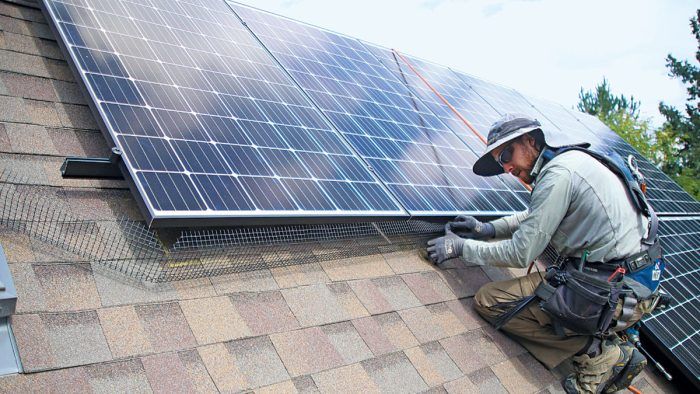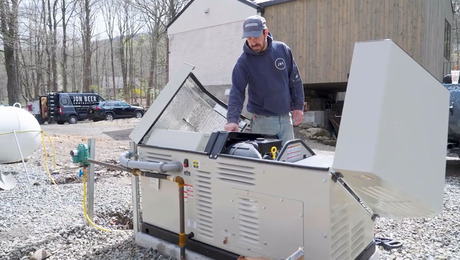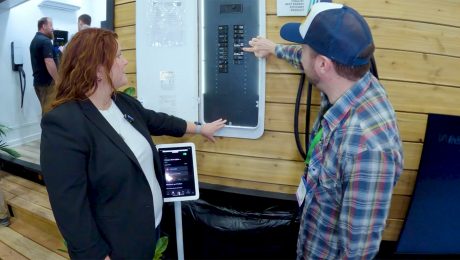Inflation Reduction Act: Energy Upgrades and Tax Credits
Explore the details of this landmark legislation and learn how it can benefit homeowners and contractors.

This article originally appeared as The Inflation Reduction Act and Residential Tax Credits on Green Building Advisor, where you can find other content related to the IRA.
On August 16, the Inflation Reduction Act (IRA) became law. The IRA is multifaceted; its 730 pages touch on, among other things, prescription drug pricing and tax reform. But most of the act deals in one way or another with energy and climate. The IRA aims to increase manufacturing and deployment of low-carbon technologies in transportation, buildings, and power generation and puts the U.S. on track for a 40% reduction in CO2 emissions by 2030. It also addresses environmental justice and energy affordability with programs targeted at low-to-moderate income (LMI) households and frontline communities impacted by pollution and climate change.
The IRA will likely shape the green building movement for decades. In upcoming articles (on GBA), I’ll explore different aspects of this landmark legislation. Details of some programs are still unfolding as Federal and State agencies work to implement the act’s provisions. For now, I’ll focus on sections of the bill that are already fairly clear: the extension and expansion of tax credits for energy efficiency upgrades, clean energy projects, and new energy-efficient homes. Homeowners and contractors with qualifying projects completed (or on track for completion) in 2022 may be able to use these credits to cut their tax bills. Longer term, the increased scope and dollar value of these credits—and the stability provided by their decade-long extension—should boost efficiency, renewables, and home electrification. In the short term, the steep increase in some tax credits after the new year and the possibility of additional rebates mandated elsewhere in the IRA may cause confusion as homeowners try to time their projects to maximize their savings.
The Energy Efficient Home Improvement Credit
Federal tax credits for efficiency measures in existing homes (renamed the “Energy Efficient Home Improvement Credit” in the new legislation and also referred to as the “25C tax credit” after the relevant section of the Internal Revenue Code) were established by the Energy Policy Act of 2005. The 2005 act allowed homeowners to claim a fixed tax credit for qualifying HVAC and water-heating equipment. For insulation, roofing, windows, doors, and skylights, homeowners could claim up to 10% of the material costs; installation costs were excluded. The criteria for qualifying products were generally aligned with those of the Energy Star Program.
The 25C tax credit, as originally written, had several weaknesses. One was its low dollar value. The credit had a lifetime cap of $500 for all measures combined, and there were lower credits for individual measures: $300 for a heat pump, air conditioner, or water heater, and $150 for a furnace or boiler.
For envelope measures like window replacement and added insulation, the original 25C tax credit applied to materials but not labor, requiring contractors to itemize costs. Air-sealing materials could be included if they had a manufacturer’s certification statement. But labor costs were always excluded. This meant that a $3000 insulation and air-sealing scope, which used $1000 of cellulose, caulk, and foam, would only qualify for a $100 credit. The credit for windows was capped at $200.
The 25C tax credit expired at the end of 2017; in late 2019, it was extended retroactively for 2018–2019 and proactively for 2020. In late 2020, the credit was extended again but expired on December 31, 2021. The uncertainty around these last-minute extensions made it hard for homeowners and contractors to factor the tax credits into their decisions. And the credit applied only to measures installed in the taxpayer’s primary residence; improvements to second homes and vacation residences were not eligible.
The new legislation extends the 25C tax credits through December 31, 2032, allowing contractors and homeowners to build them into their long-term planning. For 2022, the previous limits remain in place. Beginning in 2023, the credits will be expanded significantly, and many of their earlier shortcomings will be addressed. Important changes include:
- The credits are no longer limited to primary residences but apply to any dwelling “used as a residence by the taxpayer.”
- The credits increase from 10% to 30% of eligible measure costs. To qualify, the measures must be installed in the calendar year for which credits are claimed.
- The $500 lifetime cap has been replaced by a $1200 annual cap. If the measures installed include a heat pump or heat pump water heater, the cap increases to $2000. (Under the new rules, the 25C credits remain nonrefundable. According to the IRS, “A nonrefundable tax credit allows taxpayers to lower their tax liability to zero, but not below zero.”)
- Biomass stoves and boilers, formerly covered by the 25D credits described below, now qualify for 25C credits with an annual cap of $2000.
- Energy audits on a primary residence have been added to the list of eligible measures, as have air-sealing and electrical upgrades installed in conjunction with other qualified improvements.
- Energy Star “cool” roofing, which reduces solar gains and urban heat island effects, was formerly eligible for the credit. Effective June 1, 2022, the Energy Star program withdrew certification for roofing products. The IRA abolishes the 25C credit for roofing completely.
- Taxpayers can now claim the credits on labor and material costs for all eligible measures.
- High-efficiency air conditioners and fossil-fuel furnaces, boilers, and water heaters still qualify for tax credits, though with lower caps than heat pump equipment.
- Individual measure caps have been updated, as shown in the table shown here: Summary of changes to 25C tax credits under the Inflation Reduction Act. (For details, including 2022 efficiency requirements, see the EnergyStar website.)
The changes substantially increase the Federal tax credits available for efficiency improvements. However, they do come with a few quirks. The steep increase in tax credits in 2023 may prompt some homeowners to postpone work until the new year. As a result, the short-term effect of the act may be to delay, rather than accelerate, efficiency work. And homeowners who put off projects waiting for larger tax credits may find some of their gains eaten up by increases in equipment pricing.
The potential for large rebates for efficiency and electrification under the HOMES and High-Efficiency Electric Home programs may also lead some homeowners to delay work until they see if they qualify for these incentives. I’ll touch on both of these programs below. Homeowners can combine the 25C tax credits with the rebates once the latter become available. But customers who move forward before the programs roll out may risk missing out on these rebates.
The annual caps on credits may also lead some homeowners to break their projects up over multiple years. While a well-planned phased retrofit (ideally starting with envelope measures that reduce the size and cost of new HVAC systems) can yield excellent results, a piecemeal approach can drive up costs and lead to poor outcomes.
The Clean Energy Credit
Tax credits for residential renewable energy and geothermal systems are covered under Section 25D, now renamed the “Clean Energy Credit.” These tax credits, also established by the Energy Policy Act of 2005, originally covered photovoltaics (PV), solar water heating, and fuel cells; they have since been expanded to include small wind systems and geothermal heat pumps. The 25D credits have historically been more generous than those for efficiency. The credit percentage started at 30%; it dropped to 26% in 2020. It was scheduled to drop again, to 22%, in 2023 before disappearing at the end of 2024.
The original $2000 cap was eliminated in 2008; the credit now has no maximum amount. The entire installed cost, including equipment, materials, and labor, is eligible for the credit, as are energy storage systems installed in conjunction with on-site renewables. The credit can be applied to new or existing construction, primary and secondary residences, and shares in community solar projects. Like the 25C credits, the 25D credits are nonrefundable; however, the IRS allows surplus 25D credits to be carried over from one year to the next.
The IRA restores the 25D tax credit to 30% for projects completed in 2022 and extends it at this level through the end of 2032. The credit will decrease to 26% in 2033 and 22% in its final year, 2034. The increased credits will make large investments in clean energy more palatable for those with enough tax liability to use them. As with 25C, the stability provided by the long-term extension of the 25D tax credits benefits contractors installing these systems.
One noteworthy change to the 25D credits is that they can now be applied to standalone battery systems providing at least 3 kWh storage. This change recognizes the time-shifting and demand management benefits that “behind the meter” storage can provide to the grid. It will be particularly interesting to homeowners with sites unsuitable for PV installation. Another is that biomass stoves and boilers, formerly covered under 25D, are now included in 25C.
The 25D credits can reduce the net cost of a PV or geothermal system by tens of thousands of dollars, and the credits often factor prominently in sales presentations. Contractors have found creative ways to improve customers’ (and their own) cash flows in the months between the start of a project and the arrival of the tax refund. Some offer bridge loans that customers can pay off once their refund is received. Others suggest that customers “harvest” their tax credits early by reducing their withholdings instead of waiting for a refund. (Disclaimer: I’m a contractor, not a tax advisor. Questions regarding the application of these credits in a specific situation should be referred to a qualified professional.)
New Energy-Efficient Home Credit
The 25C and 25D tax credits are claimed by taxpayers for improvements to their residences. The IRA also extends and expands tax credits for builders of energy-efficient single-family homes (including site-built and manufactured homes) and multifamily buildings.
Like the 25C and 25D tax credits, the New Energy Efficient Home (45L) credit was established by the 2005 Energy Policy Act; it was extended several times before expiring at the end of 2021. The 45L credits in effect in 2021 offered builders of site-built homes $2000 per home if modeled energy consumption was 50% below the consumption of a similar home built to the 2006 International Energy Conservation Code (IECC). The credit also required that envelope improvements provide at least 20% of these savings. Manufactured homes could qualify for the $2000 credit by meeting these standards or a lower credit by achieving either a 30% energy reduction or Energy Star certification.
The IRA renews the 45L credits at these levels for homes completed in 2022. For homes completed between 2023 and 2032, the IRA establishes larger credits:
- Site-built single-family homes that meet Energy Star standards qualify for $2500. Homes built in 2023 and 2024 must meet Energy Star v3.1; homes built later must meet v3.2 (the act leaves open the possibility of further revisions to the Energy Star standards; if these revisions occur, builders will have a two-year grace period in which they can claim credits for homes built to v3.2).
- Manufactured homes meeting the most recent Energy Star standards also qualify for a $2500 credit.
- Site-built and manufactured homes certified under the DOE’s more stringent Zero Energy Ready Home program qualify for $5000.
- Multifamily homes that meet Energy Star Multifamily New Construction Program qualify for a $500/unit credit. This increases to $2500/unit if crews and subcontractors are paid prevailing wage.
- Multifamily homes that meet Zero Energy Ready standards qualify for $1000/unit, increasing to $5000/unit with prevailing wage.
Both the Energy Star and Zero Energy Ready Home standards will require verification by a third party, such as a home energy rater.
Rebate programs
In addition to the 25C, 25D, and 45L tax credits, the IRA contains two rebate programs aimed at reducing energy use and increasing electrification, especially in LMI households. LMI households spend a higher portion of their income on energy than more affluent ones. They may also struggle with the cost of energy-related improvements and may not have enough tax liability to take full advantage of nonrefundable credits. The IRA provides enhanced incentives for LMI households; eligibility is determined by a household’s income relative to the area median income (AMI).
The HOMES program sets aside $4.3 billion for performance-based whole-house rebates. The funds will be administered by state energy offices under guidelines that will be established by the U.S. Department of Energy. States must apply for funding, which will be allocated based on population and energy use.
The HOMES program provides two tiers of rebates. Households of all income levels are eligible, with higher percentages and caps for households below 80% of AMI.
HOMES also offers two methods for calculating incentives. The Modeled Energy Savings pathway uses estimates of energy savings calculated in accordance with the BPI 2400 standard. BPI 2400 requires the use of approved software that trues up energy models with records of historical energy use. Modeled savings of 20-35% will allow higher-income homeowners to qualify for a 50% rebate with a maximum rebate of $2000. For LMI homeowners, the rebate is 80% of the project cost, up to a maximum of $4000. For projects with modeled energy savings exceeding 35%, the percentages remain the same, but the caps increase to $4000 (non-LMI) and $8000 (LMI).
The Measured Energy Savings pathway bases incentives on reductions in actual energy use following energy improvements. The analysis must be conducted with DOE-approved software, which will account for pre- and post-retrofit weather. This pathway requires a minimum savings of 15%; actual rebate amounts are calculated using a formula that factors in measured savings and average household energy use in that state. Rebates levels are higher for LMI households. Rebates are capped at 50% (non-LMI) or 80% (LMI) of a project’s cost.
Both pathways also include rebates for retrofits of multifamily buildings.
The High-Efficiency Electric Home Rebate program sets aside $4.5 billion to provide LMI households with point-of-sale rebates on efficient electric appliances and associated upgrades. Like HOMES, these rebates will be administered by state energy offices. The rebate will cover the full cost of qualifying appliances for households below 80% of AMI. For households between 80% and 150% of AMI, the rebates cover 50% of the cost. The maximum total rebate is capped at $14,000 per household; caps for specific appliances and measures are as follows:
- Heat pump: $8000
- Heat pump water heater: $1750
- Electric stove, cooktop, range, oven, or heat pump clothes dryer: $840
- Electric load service upgrade: $4000
- Wiring upgrades: $2500
- Insulation and air-sealing: $1600
The IRA prohibits homeowners from receiving HOMES and High-Efficiency Electric Home rebates for the same measure. However, nothing in the act prevents homeowners from combining rebates with 25C credits.
Rich incentives, complicated rollout
The tax credits and rebates contained in the IRA provide substantial assistance to homeowners seeking to cut their energy costs and reduce their carbon footprints. Once in place, these incentives will also drive significant revenue and job growth in the green building industry. Targeted federal investments will accelerate the shift to energy-efficient, low-carbon housing. They will also reduce the burden of high energy costs, particularly for LMI households. If administered well, these investments may produce a multiplier effect like the DOE’s Weatherization Assistance Program. A dollar spent on weatherization yields, on average, nearly three dollars in benefits as money from energy saved and jobs created circulates in local economies.
But, in the short term, the IRA may cause some homeowners to delay moving ahead. The expanded 25C, 25D, and 45L tax credits take effect on January 1, 2023. The rebate programs will take longer. The Department of Energy has yet to issue guidance to states on how to apply for rebate funding; states will then need to apply. Once approved, state energy offices will need to set up programs and recruit contractors. I’ll be surprised and delighted if I can offer my customers these rebates a year from now.
In the meantime, I know I’ll be fielding inquiries from interested customers. The extended rollout creates a dilemma: We want to get our customers all the incentives for which they’re eligible; if we push them to move ahead prematurely, they may risk losing out. This concern is especially acute when working with LMI customers whose potential rebates are larger, both in dollars and in relation to their household budgets. But we also owe it to ourselves and our employees to keep work flowing until the rebates are in place.
What’s a contractor to do? For starters, it’s important to stay current on the status of the tax credits and rebates so that we can be a reliable—and trusted—source of information. It’s also important to set realistic expectations. In the best-case scenario, the rebates are still several months off. And nine billion dollars, though a huge sum, won’t go that far when it’s divided among 50 states. I imagine that once the programs are rolled out, the rebate money will be exhausted rapidly.
It’s also worth mentioning that waiting carries its own risks: equipment and material prices will almost certainly increase; energy savings will be postponed; and, if existing mechanical equipment is nearing its life expectancy, the chance of needing an emergency replacement will increase. The ethical course is to share what we know with customers in a balanced and transparent way, then let them decide how to proceed. Once we get through this awkward launch, the IRA will help us stay busy for years.
Jon Harrod is founder of Snug Planet, a contracting company in Ithaca, N.Y.
RELATED STORIES

























